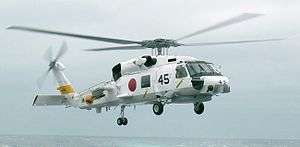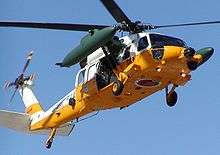Mitsubishi H-60
| SH-60J/K Seahawk UH-60J/JA Black Hawk | |
|---|---|
 | |
| A JMSDF SH-60J Seahawk helicopter from JDS Haruna lands onboard USS Russell in 2007. | |
| Role | ASW/SAR helicopter |
| National origin | Japan |
| Manufacturer | Sikorsky Aircraft Mitsubishi Heavy Industries |
| First flight | 31 August 1987 |
| Introduction | 1991 |
| Status | In service |
| Primary user | Japan Self-Defense Forces |
| Number built | 178 |
| Developed from | Sikorsky SH-60 Seahawk Sikorsky UH-60 Black Hawk |
The Mitsubishi H-60 series is twin-turboshaft engine helicopter based on the Sikorsky S-70 helicopter family for use by the Japan Self-Defense Forces (JSDF). The SH-60J/K are anti-submarine patrol version for the Japan Maritime Self-Defense Force (JMSDF).[1] The UH-60J is a search and rescue version for the Japan Air Self-Defense Force (JASDF) and JMSDF. The UH-60JA is a utility version for the Japan Ground Self-Defense Force (JGSDF).[2]
Design and development
SH-60J
The JMSDF chose SH-60B Seahawk as the successor of the Mitsubishi HSS-2A/B Sea King. The Japan Defense Agency acquired a S-70B-2 from Sikorsky for study in 1985. The Defense Agency was going to develop Light Airborne Multi-Purpose System (LAMPS) Mk III for Japan, but it was declined by the United States, and most avionics sets were developed in the Technical Research and Development Institute.[3] The Defense Agency ordered two XSH-60Js from Sikorsky for $27 million. Their first flights were on 31 August and in October 1987. The Defense Agency designated the model SH-60J. They were fitted with Japanese avionics systems and tested by the JMSDF.[4]
The SH-60J is built in Japan under license from Sikorsky. It began deliveries in August 1991 and entered service thereafter. Based on a concept of the JMSDF, HQS-103 Dipping Sonar, HPS-104 active electronically scanned array Search Radar, and HLR-108 ESM System equipment of the avionics of SH-60B be different.[3] The engine is the GE/IHI T700-IHI-701C turboshaft, which Ishikawajima-Harima Heavy Industries produced under license. It is a hybrid of SH-60B and SH-60F, except for avionics. The crew includes a pilot, copilot and sensor operator. The copilot can concentrate on the role of Tactical Coordinator with the help of the Automatic Flight Management System and Inertial Navigation system.[5][6] Over 100 SH-60Js have been produced by 2007.[7]
SH-60K
The SH-60K is an upgraded version of the SH-60J.[8] The SH-60K anti-submarine helicopter which strengthened performance and versatility for the JMSDF. Mitsubishi began development in 1997. The SH-60K has formerly known as SH-60Kai.[9] The Director General of the Defense Agency admitted adoption in March 2005.[10]
Mitsubishi developed new main rotor blade, Ship Landing Assist System, new avionics system, and other systems. Two prototypes SH-60Ks were built by modifying SH-60Js. These prototypes were completed and delivered by June 2002. The SH-60K's cabin was expanded in length by 30 cm (11.8 in) and in height by 15 cm (5.91 in) compared to the SH-60J.[10] The larger cabin allows for the new avionics system.[11] Those and the airframe changes are compensated by the exchange of the T700-IHI-401C2 engine. The first production SH-60K was delivered to JMSDF on 10 August 2005.[10] A total of 50 SH-60Ks are being supplied under new production.[9]
UH-60J

In 1988, the Japan Air Self-Defense Force choose the UH-60L to replace its KV-107 and Sikorsky S-62 helicopters.[12][13] The first aircraft was built by Sikorsky, with the company designation S-70A-12, and two more were assembled by Mitsubishi Heavy Industries.[2][14] Mitsubishi is producing the remaining UH-60Js under license.[15][16] The Japan Marine Self-Defense Force also chose Search and rescue, and utility helicopters to replace the S-61A in 1989.
The UH-60J is powered by T700 engines license-built by Ishikawajima-Harima Heavy Industries in Japan. It features external fuel tanks, an external rescue winch, a Japan-built radar, a FLIR turret in the nose and bubble side windows for observers.[13] The Japan Air Self-Defense Force machines were fitted with T700-IHI-701A engines, while Japan Maritime Self-Defense Force machines were fitted with marinized T700-IHI-401C engines.[14] Fuel tanks can be attached to pylons on stub wings. The UH-60Js began deliveries in 1991 and entered service in 1992.[17] A total of 40 UH-60Js were in service in 2010. The JASDF ordered 40 newer UH-60Js in December 2010 to begin replacing older UH-60Js.[18]
Mitsubishi and Sikorsky have teamed in support of the Self Defense Force's mission requirements. The UH-60J+ incorporates various upgrades for the modern SAR mission.[19] By 2006 Defense budget of Japan, UH-60Js begin addition of Refueling probe in 2009.[20] These UH-60Js completed training with the United States Air Force and widened their activity in SAR mission.[21]
UH-60JA
The Japan Ground Self-Defense Force ordered a utility variant of the UH-60L designated UH-60JA in 1995.[17] The JGSDF began receiving the UH-60JA in 1997.[2] It features improved avionics, including FLIR, Color weather radar, GPS receiver, a Night Vision Goggle compatible cockpit and wire cutter.[14][17] The JGSDF plans to acquire 70.[22]
The JGSDF plan was to replace its UH-1H helicopters which became obsolete. Due to budgetary constraints it was decided to replace the rotary wing fleet with a high-low combination of UH-60JA and UH-1J (an updated UH-1H) with the UH-60JA being the high and the UH-1J the low.[23] By 2004 the budgetary constraints have driven the JGSDF to seriously consider eliminating either the UH-60JA or the UH-1J from the fleet, and purchasing just one type of airframe for the utility mission.[24]
Variants
.jpg)
- S-70B-2: Version purchased from Sikorsky for research by the Defense Agency.
- XSH-60J: Prototype for SH-60J. 2 XSH-60Js were exported by Sikorsky.
- SH-60J: Seahawk version for the Japan Maritime Self-Defense Force produced by Mitsubishi under licence.[1]
- UH-60J: Rescue helicopter license produced by Mitsubishi for the Japan Air Self-Defense Force and the Japan Maritime Self-Defense Force.[12][13]
- UH-60JA: Utility version for the Japan Ground Self-Defense Force based on the UH-60J.[22]
- USH-60K: Among two prototypes, one was redesignated as evaluation type.[25]
- SH-60K: Improved version of SH-60J. Trial manufacture finished in 2001, and deliveries began in August 2005.[8]
Operators
- Japan Air Self-Defense Force has 31 UH-60Js in operation as of Nov. 2008.[26]
- Akita Air Rescue Wing : UH-60Js Search and rescue wing.
- Ashiya Air Rescue Wing
- Chitose Air Rescue Wing
- Hamamatsu Air Rescue Wing
- Hyakuri Air Rescue Wing
- Komatsu Air Rescue Wing
- Matsushima Air Rescue Wing
- Naha Air Rescue Wing
- Niigata Air Rescue Wing
- Nyutabaru Air Rescue Wing
- Japan Ground Self-Defense Force has 27 UH-60J/JAs in use as of Nov. 2008.[26]
- 15th Brigade
- No. 15 Helicopter Wing (Camp Naha): UH-60JAs Search and rescue squadron.
- 1st Helicopter Brigade
- No. 102 Squadron (Camp Kisarazu): UH-60JAs Subsidiary Air assault unit.
- 12th Brigade
- No. 12 Helicopter Wing 1st Squadron (Camp Kita-Utunomiya)
- Western Army Aviation Group
- Western Helicopter Wing (Camp Metabaru)
- Kasumigaura Aviation School
- Educational Support Squadron
- 15th Brigade
- Japan Maritime Self-Defense Force has 102 SH-60J/Ks and 19 UH-60Js in service as of Nov. 2008.[26]
- No. 21 Squadron (Tateyama Air Base): Fleet Air Force having SH-60J and SH-60K.
- No. 22 Squadron (Ōmura Air Base): Fleet Air Force.
- No. 51 Squadron (Naval Air Facility Atsugi): Operational Evaluation Unit.
- No. 72 Squadron (Tateyama Air Base, Ominato Naval Base and Iwojima Air Base): UH-60Js Search and rescue squadron.
- No. 73 Squadron (Ōmura Air Base, Tokushima Air Base and Kanoya Air Base)
Specifications (SH-60J)
General characteristics
- Crew: 3
- Length: 19.8 m (64 ft 10 in)
- Rotor diameter: 16.4 m (54 ft 6 in)
- Height: 5.2 m (16 ft 12 in)
- Max. takeoff weight: 9,750 kg (21,495 lb)
- Powerplant: 2 × Ishikawa-Harima T700-IHI-401C turboshaft, 1,342 kW (1,800 shp) each
Performance
- Maximum speed: 264.8 km/h (143 kn, 165 mph)
- Range: 584 km (315 nmi, 363 mi)
- Service ceiling: 5,790 m (18,996 ft)
Armament
- 2 × Mark 46 torpedo
- 1 × 7.62 mm (.30 in) Type 74 machine gun
- Type 74 torpedo
- Type 12 torpedo
- AGM-114 Hellfire
- Depth charge
See also
- Related development
- Sikorsky S-70
- UH-60 Black Hawk
- SH-60 Seahawk
- HH-60 Pave Hawk
- HH-60 Jayhawk
- Piasecki X-49
- CH-148 Cyclone
- Aircraft of comparable role, configuration and era
- Related lists
References
- Notes
- 1 2 Mitsubishi SH-60J. Mitsubishi Heavy Industries, Ltd. Retrieved: 10 December 2008
- 1 2 3 Mitsubishi UH-60J. Mitsubishi Heavy Industries, Ltd. Retrieved: 15 March 2010.
- 1 2 Goebel, Greg. Sikorsky S-70B Seahawk / Variant, Air Vector, vectorsite.net, 1 April 2009.
- ↑ "Sikorsky SH-60B". All the World's Rotorcraft. Jane's Information Group, 2010. subscription article dated 1 February 2010.
- ↑ "AFMS controller for the SH-60J". Jane's Avionics. Jane's Information Group, 24 January 2007. Retrieved: 18 December 2008.
- ↑ "Strapdown Attitude and Heading Reference System for the SH-60J". Jane's Avionics. Jane's Information Group, 24 January 2007. Retrieved: 18 December 2008.
- ↑ Leoni 2007, p. 280.
- 1 2 Mitsubishi SH-60K, Mitsubishi Heavy Industries, Ltd. Retrieved on 10 December 2008.
- 1 2 "Mitsubishi SH-60K Upgrade". Jane's, 11 June 2008.
- 1 2 3 Mitsubishi Heavy Industries, Ltd. "Development of SH-60K Patrol Helicopter" (PDF). Technical Review Vol. 42 No. 5 (Dec. 2005). Retrieved 6 January 2009.
- ↑ Goebel, Greg. "Seahawk in Foreign Service". Vectorsite.net, 1 April 2009.
- 1 2 Leoni 2007, p. 282.
- 1 2 3 Bishop 2008, p. 40.
- 1 2 3 Goebel, Greg. Sikorsky S-70 Black Hawk. Vectorsite.net, 1 April 2009. Retrieved: 21 December 2010.
- ↑ "Mitsubishi (Sikorsky) UH-60J". Jane's Helicopter Markets and Systems. Jane's Information Group, 2009. subscription article, dated 16 November 2009.
- ↑ "Mitsubishi (Sikorsky) UH-60 (Japan)". Section Aircraft - Rotary-wing - Military, Jane's All the World's Aircraft. Jane's Information Group, 27 January 2010. Retrieved: 24 September 2010.
- 1 2 3 Bishop 2008, p. 41.
- ↑ Waldron, Greg. "Mitsubishi wins $2.3bn deal for 40 UH-60Js". Flight International, 9 December 2010.
- ↑ Sikorsky Frontlines Q1 2009. Sikorsky, Q1 2009. Retrieved: 21 December 2009.
- ↑ "Section 3. Mid-Term Defense Program". Annual White Paper, DEFENSE OF JAPAN 2008. Japan Ministry of Defense. Retrieved: 4 August 2010.
- ↑ Angelique Perez. "33RQS helicopter pilots give air refueling training to JASDF". US Air Force Kadena Air Base, 2 April 2009. Retrieved: 15 March 2010.
- 1 2 Leoni 2007, pp. 282-283.
- ↑ "Japan's new utility helicopter makes debut". Jane's Information Group, 29 September 1999. Retrieved: 11 August 2010.
- ↑ Sobie, Brendan. "Japan rethinks helicopter needs". Flight International, 16 March 2004. Retrieved: 11 August 2010.
- ↑ "Mitsubishi-Sikorsky UH-60 BlackHawk / SH-60 SeaHawk". HIKOTAI.net. Retrieved 2010-12-22.
- 1 2 3 "Directory: World Air Forces". Flight International, 11–17 November 2008.
- Bibliography
- Leoni, Ray D. Black Hawk, The Story of a World Class Helicopter, American Institute of Aeronautics and Astronautics, 2007. ISBN 978-1-56347-918-2.
- Bishop, Chris. Sikorsky UH-60 Black Hawk, Osprey Publishing, 2008. ISBN 978-1-84176-852-6.
External links
| Wikimedia Commons has media related to Mitsubishi SH-60. |
| Wikimedia Commons has media related to Mitsubishi UH-60. |
- SH-60J page on Mitsubishi Heavy Industries site
- SH-60K page on Mitsubishi Heavy Industries site
- UH-60J page on Mitsubishi Heavy Industries site
- SH-60J page and UH-60J page. GlobalSecurity.org.
- Rightwing. "SH-60J patrol helicopter" (in Japanese).
- Brendan Sobie (25 November 2003). "SH-60K production begins after one-year delay". Flight International.